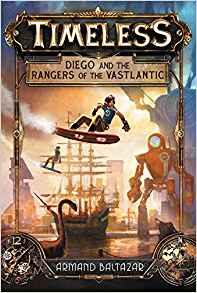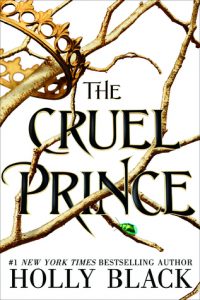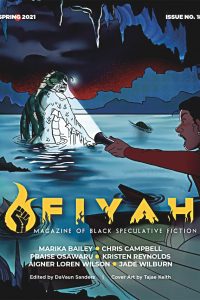Karen Haber Reviews Art Books
 Timeless: Diego and the Rangers of the Vastlantic, Armand Baltazar (Katharine Tegen 978-0-06-240236-3, $19.99, 607pp, hc) October 2017. Cover by Armand Baltazar.
Timeless: Diego and the Rangers of the Vastlantic, Armand Baltazar (Katharine Tegen 978-0-06-240236-3, $19.99, 607pp, hc) October 2017. Cover by Armand Baltazar.
Paperbacks from Hell: The Twisted History of ’70s and ’80s Horror Fiction, Grady Hendrix (Quirk 978-1-5947-4981-7, $16.95, 256pp, tp) September 2017.
Flora & Fauna, J.A.W. Cooper (Flesk 978-1-933865-96-6, $25.00, 80pp, tp) October 2017. Cover by J.A.W. Cooper.
Familiars, J.A.W. Cooper (Flesk 978-1-933865-95-9, $25.00, 80pp, tp) October 2017. Cover by J.A.W. Cooper.
Viscera, J.A.W. Cooper (Flesk 978-1-933865-97-3, $25.00, 80pp, tb) October 2017. Cover by J.A.W. Cooper.
The Fantastic Line Art of Arthur Rackham, Jeff A. Menges, ed. (Dover 978-0-486-81422-3, $16.95, 161pp, tp) November 2017. Cover by Arthur Rackham.
Timeless, an alternate-universe, middle-grade, illustrated first-novel from artist, animator, and writer Armand Baltazar, offers excellent storytelling in both text and image. Set in a post-apocalyptic world in which time and space have fractured, forcing different eras and historical cultures into a wild mashup, Timeless is the story of 13-year-old Diego Ribera and his quest to rescue his father and preserve the fragile world he lives in.
This would have made an interesting graphic novel. The ambitious, sprawling, and satisfying tale is just begging for animation, and is reportedly the first of a series by Baltazar.
A hefty volume, with 600+ pages printed on glossy paper with 150+ full-color illustrations by the author, nice graphic design details, two-page spreads and full- and half-page bleeds of images, it contains almost too much information, both visual and text, for one book. The illustrations are full of action, adventure, and strange combinations: hoverboards and dinosaurs, robots and steam-driven stagecoaches.
This is a promising first novel by Baltazar, who has worked as a background artist, visual indevelopment artist, and art director for DreamWorks Studios, Walt Disney, and Pixar Animation. The handsome volume, with attractive dust-jacket and internal design elements, good-size text and typeface, will provide lots of good visual fun in a world filled with clashing, anachronistic wonders.
Paperbacks from Hell by Grady Hendrix is not just a book about paperback horror covers but one that discusses the twisted pleasures of the horror fiction that emerged in the 1970s and ’80s. Novelist Hendrix’s comic sensibility pervades this almost-camp approach to a seminal period for horror fiction and cover art.
The entertaining text offers information on the lives of the artists, witty synopsis of plots, development of the horror genre from pulp occult action novels, and much more. His enthusiasm and knowledge are infectious
Among the more entertaining segments: “What to Expect When You’re Expecting (a Hell Baby)”, “Salad of the Damned”, “Toys ‘R’ Death”, “Today’s Menu: You”, and “Hello, Clarice”.
The list of artists includes some familiar names: Joe DeVito, Bob Eggleton, James Warhola, Iain McCraig, John Berkey, Don Ivan Punchatz, Anne Rivers Siddons, Richard Powers, Wayne Barlow, Les Edwards, and J.K. Potter. Certain artists – Jeffrey Catherine Jones, Jill Bauman, Ron Sauber, Rowena Morrill, Jim Thiesen, Lisa Falkenstern, and Tom Hallman among them – get one-page featurette shout-outs.
With 350 full-color reprints, the book has a consistent utilitarian design. Many of the covers are reproduced at good size, but crowding can be a problem with more than three images per page. Occasionally a cover detail will be expanded so that viewers can appreciate the artwork.
Included in the appendices: a selection of capsule bios of horror creators and publishers, an Afterword by Will Errickson providing a recommended reading list, and several pages of publisher and cover artist credits. Many a horror fiction enthusiast will come away from this book with an expanded reading list. Paperbacks from Hell is funny and fun even if you’re not a diehard fan of the genre.
The Art of J.A.W. Cooper: Familiars, Flora and Fauna, and Viscera, the slipcovered threebook set of drawings and paintings by artist J.A.W. Cooper, is the deluxe result of a very successful Kickstarter campaign by Flesk Publications. The books, available as individual paperbacks or as the hardcover set, display Cooper’s technical mastery and unique sensibility.
Cooper, whose work has appeared in the Spectrum art annual, is fascinated by flora and fauna, as these sketchbooks reveal. Her beautiful linework combined with her quirky, often-macabre taste, out-there sense of humor, and careful observation of the natural world provides remarkable artwork you won’t soon forget.
There are tattooed women, tigers, strange hybrid jellyfish beings, hairless cats, dogs and skulls, grotesques, chinchillas, and much more artwork displaying Cooper’s blend of surreal, funny, erotic, and ferocious imagery.
Born in England, Cooper grew up in Kenya, Sweden, and Ireland, and traveled in Europe with her South African/British mother and American father, both of whom were freshwater ecologists. Her mother, a scientific illustrator, particularly influenced and inspired her.
In the artist’s foreword to the Viscera volume, she recalls a childhood event in Kenya that involved bloodletting and a cow: “This visceral image of violence and the joyous air of celebration united in a single moment of intense focus….” The same might be said for many of the images limned in these three volumes. Fascinating work, beautifully presented, and not for the faint-hearted.
From Dover Press comes The Fantastic Line Art of Arthur Rackham, selected and edited by Jeff A. Menges, another in a series of reprinted work by renowned fantasy illustrator Arthur Rackham (1867-1939) – Peter Pan in Kensington Gardens, The Romance of King Arthur and His Knights of the Round Table, Fairy Tales of the Brothers Grimm.
Dover Press – and others, see below – has done a better job with Rackham’s work in earlier publications. No one slim volume could do justice to Arthur Rackham’s genius, and this crowded, unattractive, cheap compilation of black-and-white linework will only whet your appetite for more and better information and reproductions. The brief introduction by editor Menges sets Rackham in context as a late 19th-century/early 20th-century illustrator. Two articles reproduced from early 20th-century magazines give a taste of the illustrator’s personality and environment.
If this brief glimpse whets your appetite for more, see: Arthur Rackham: A Life with Illustration Hardcover, James Hamilton (Pavilion, 2011); The Arthur Rackham Treasury: 86 Full Color Illustrations, Jeff A. Menges, ed. (Dover 2005); and the many other Dover Press collections of Rackham’s artwork, or these websites: <www.bpib.com/illustrat/rackham.htm>, <www.brainpickings.org/2016/02/01/arthur-rackham-alice-in-wonderland>, and <www.peterharrington.co.uk/blog/the-golden-age-of-illustration-arthur-rackham>.
This review and more like it in the February 2018 issue of Locus.







